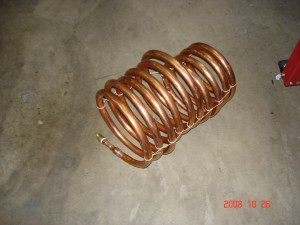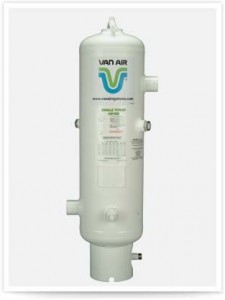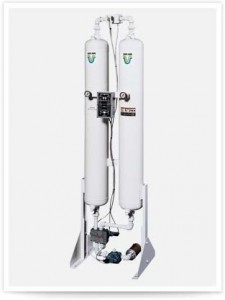What is a Compressed Air Dryer?
Definition
A compressed air dryer is a device for removing water vapor from an air system. That is, an air dryer’s main function is not removing liquid water, which is the role of a compressed air moisture separator and coalescing filter.
Compressed Air Dryer vs. Moisture Separators
Many owners of compressed air systems overlook this distinction, and that’s not just a problem of semantics. If you think you’ve got a dryer – but really don’t – then you’ll be frustrated and perplexed when condensation still appears at your points of use. For whatever reason, this problem is especially common in the abrasive blasting and coatings industry. For a number of years I’ve exhibited Blast Pak series air dryers at the annual trade show of the Society for Protective Coatings (SSPC).
I often talk to blasting and coatings contractors about how only a true dryer delivers productivity benefits: good flow of blast media, reductions of re-work and down time, and protection of nozzles.
Over the years I’ve visited with painting contractors who’ve shown me some very creative air dryers. A while back I called on a large contractor to talk about our Blast Pak portable dryers. He said that he already had some dryers. He took me out into his yard and pointed to several 55 gallon drums.
Inside each drum was a large copper coil submerged in water. The idea is that by cooling compressed air, water vapor condenses. He’d attached a small moisture separator with a manual drain valve to the end of each coil.
I asked him, "What happens when the incoming hot compressed air heats the cooling water, and it no longer cools the compressed air and condenses out liquid?"
He said that he sends his workers out for bags of ice and dumps them into the drums.

This copper coil serves as a heat exchanger, but that does not make it a dryer. Only a dryer will prevent condensation at the point of use.
I had to give him credit for creativity. This was one of the most clever non-air dryer dryers I’ve ever seen. But this contractor clearly wouldn’t have won any prizes for productivity. (For what it’s worth, he did eventually buy some Blast Pak air dryers from our local distributor.)
- In the abrasive blasting and painting industry it’s also common to hear moisture separators, filters, or knock out pots referred to as air dryers. While it is true these devices remove liquid water they are not air dryers. Humidity passes straight through separators and filters!
Another misconception in the marketplace is that if you have an air cooled after-cooler with a separator and drain that is the same thing as a dryer. Many new portable diesel air compressors have on-board after-coolers and filters. After-coolers will cool the air and condense out water which is then removed by the moisture separator; however it does not take the place of a compressed air dryer. If only a cooler is applied, some moisture will still condense in the point of use.
The Van Air Systems Blast Pak is a true compressed air drying system. It is a portable skid mounted package consisting of an after-cooler, deliquescent dryer, and filter. The Blast Pak cools the compressed air, separates the condensed water, and dries the compressed air to a dew point that is 10F below ambient temperature. Drying the compressed air assures the user they will no longer condense any water out in their blast pots, nozzles, or paint guns.
The so-called air dryers I have discussed above will cool the compressed air and remove the condensed water but they will not dry the air. You must add the dryer component to make sure you eliminate further condensation. The Blast Pak is a “real” compressed air dryer, but let's look at the different types.
Types of Compressed Air Dryers
There are many types of compressed air dryers, with each suited for different applications and operating conditions. Below are some basic distinctions between different types of dryers.
Deliquescent Dryers
A deliquescent air dryer is basically a pressure vessel filled with desiccant tablets, such as Van Air Systems Dry-O-Lite. Deliquescent tablets absorb moisture from wet inlet compressed air. The desiccant deliquesces, or more simply it melts as it absorbs moisture and dries the compressed air. The desiccant is consumed during the drying process. This dryer type is well suited for harsh operating environments, outdoor installations, and intermittent point-of-use applications.

Deliquescent Air Dryer, Van Air Systems Model D12
Typical applications are: sawmills, ready mix plants, foundries, landfill gas and biogas, hazardous areas, paint booths, and outdoor mobile sandblasting and surface preparation.
Deliquescent dryers have a low capital cost relative to other types of compressed air dryers.
Operating costs are determined by the rate of desiccant consumption. Electric power is not required and the pressure drop is typically 1 PSI or less
Maintenance is simple. Add desiccant as needed and drain the condensate daily. The dew point is 20⁰F to 63⁰F lower than the temperature of the compressed air.
Refrigerated Dryers
A refrigerated dryer uses a refrigerant compressor, condensing unit and heat exchanger to chill compressed air. Chilling causes water vapor to condense. Compressed air is reheated before leaving the dryer, so that the compressed air dew point is lower than its temperature.
Refrigerated dryers are ideal for continuous demand, indoor applications, where the ambient air quality is relatively clean and their air lines do not pass through an area subject to freezing temperatures. Some uses include food processing (do not, however, run air lines through a walk-in freezer when relying on a refrigerated air dryer), machine shops, and general manufacturing environments.
Refrigerated dryers typically cost slightly more than deliquescent dryers, depending on the brand and options.
The cost of operating a refrigerated air dryer is the electrical power to run the refrigerant compressor and condenser fan motor(s). Energy saving or cycling dryers are available, although their initial purchase price is more than a non-cycling dryer.
The pressure loss through a refrigerated dryer is normally 5 PSI, depending on filtration options.
Maintenance tasks includes keeping the condenser and automatic drain clean. Repairs to the refrigerant circuit require special skills.
Regenerative Desiccant Dryers
Desiccant dryers are sometimes called twin tower dryers, adsorption dryers, or regens. At Van Air Systems we usually call them regens. Regen dryers contain a reusable desiccant, typically activated alumina or molecular sieve, which adsorbs the moisture vapor from the wet inlet compressed air stream. The dryer has two pressure vessels each filled with the desiccant. Each vessel alternates between drying and regenerating. Regeneration is accomplished by using a portion of the dried outlet air or a combination of dry air and heat from an electric or steam heater. A regenerative dryer produces a -40F outlet pressure dew point.

Regenerative Desiccant Dryer - Van Air Systems Model
Typically a regenerative dryer is specified by a customer who needs virtually all of the moisture removed from the compressed air stream. Some applications include refineries, petrochemical, pharmaceutical, power plants, and most process industries. Regenerative dryers are also used when needing to protect air lines from freezing due to low ambient temperatures.
Regenerative dryers are the most expensive type of air dryer, from both an initial and an operating cost perspective. Therefore this class of dryer should only be used when the application absolutely needs -40F or -100F dew point compressed air.
Certain regenerative desiccant dryers use up to 18% of the dry process air to regenerate the off stream tower. Other types use heat plus dry process air. In either case there’s a heavy utility load needed to run this type of dryer.
Maintenance tasks include changing of filters, replacements of valve seals, monitoring of upstream drains on separators and filters, and changing of the adsorbent desiccant every 3-5 years.
The main advantage of a regenerative dryer is it virtually removes all of the moisture vapor in the compressed air stream. All processes and outdoor piping are completely protected.
Membrane Dryers
A membrane air dryer uses bundles of hollow membrane fibers. The compressed air passes thru the center of the fibers and the moisture vapor permeates thru the fiber walls. A portion of the dried compressed air is used to regenerate the membrane by sweeping away the moisture vapor. Typically 18%-25% of the dried compressed air is used for “sweep air”
This type of dryer is typically used for low flow applications up to 100 scfm or less. They are used for intermittent point of use applications such as a laboratory air, instrument cabinets, and laser purging.
Membrane dryers require little to no direct maintenance. However the membranes are high susceptible to oil and liquid contamination and pre-filters and drains must be consistently serviced. The membrane must be protected from liquid water and oil contamination so you must install a coarse coalescing & fine coalescing prefilter in series to protect the dryer.
The membrane dryer is relatively easy to install and reasonably priced for low flow applications that require a low dew point.
What is the best compressed air dryer?
That’s not an easy question to answer, and depends on the answers to a variety of more fundamental questions.
How is the compressed air being used? What ambient temperature ranges will the compressed air piping be exposed to? Are there footprint, electrical, or other constraints at the installation site?
There is no single air dryer that’s best for every application. The best compressed air dryer for a home user will be much different than for, say, a scientist in a high tech research laboratory.
To begin answering this question – what’s the best compressed air dryer? – let's first ask yet another one. What dew point do you need?
As mentioned above, a compressed air dryer removes water vapor from the air line. Water vapor is a gas. A dryer is not intended to remove liquid water. (Liquids must be separated and filtered out upstream of a dryer using liquid separators and coalescing filters.)
A dryer, by removing water vapor from the air line, lowers the dew point. Dew point is the temperature where condensation begins to form in compressed air. By removing water vapor and lowering dew point with a dryer you prevent new condensation from forming downstream in system piping and points of use.
Generally speaking, the more you want to drop the dew point, the more you’ll need to spend. The lower you drive the compressed air dew point, the more costly the dryer becomes, in terms of both capital and operating costs. Another way of putting it is that one should dry compressed air only to the extent required by the application.
The ISO standard 8573.1 defines various compressed air quality classes. This standard is helpful for quickly identifying various levels of compressed air purity, but it will not help you answer this most important question, What dew point do I need? If you’re an industrial user of compressed air you will need to further examine your air system and processes to evaluate your dew point requirements.
Without recapping all of the different types mentioned above, every application is unique. If you’re simply using air to blow dust off the floor then you probably don’t even need a dryer. But if you’re using compressed air in a process that involves, for example, contact with a food product then evaluating your dryer requirement will be of great importance. So what is the best compressed air dryer? The honest yet unsatisfying answer will always be, It depends.
